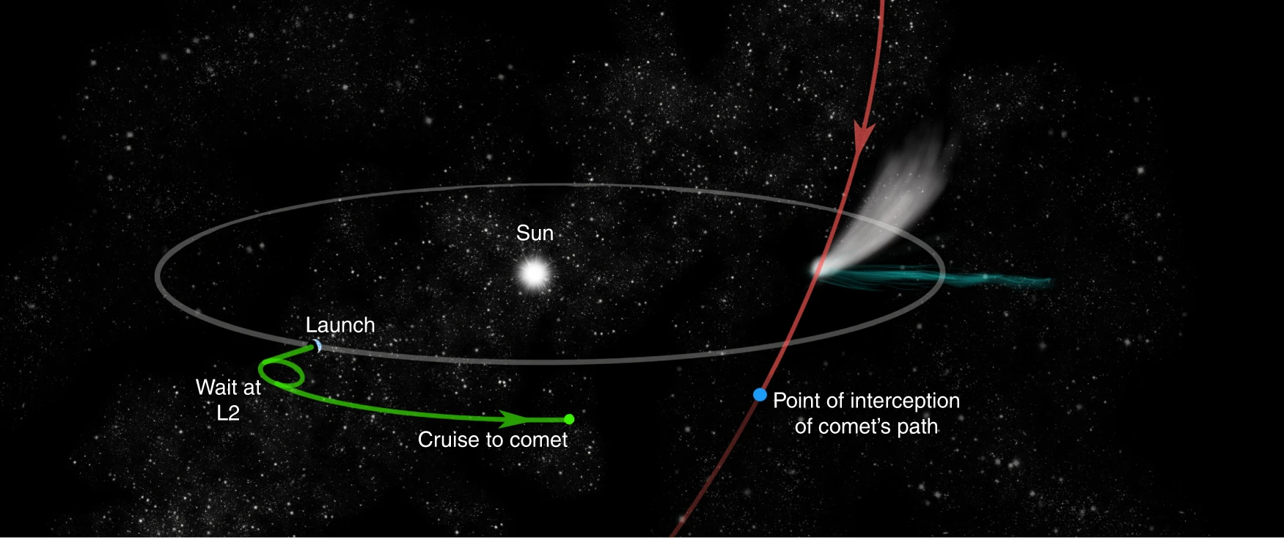Comet Interceptor: A Rapid Response Mission To a Pristine World
- 1European Space Astronomy Centre, Science Operations Department, Villanueva de la Cañada, Spain (michael.kueppers@sciops.esa.int)
- *A full list of authors appears at the end of the abstract
Introduction: Comet Interceptor is the first Fast (F-class) mission in ESA’s Cosmic Vision program [1], and is the first rapid response mission, waiting in space for its target comet to appear. Its goal is the first in situ investigation of a long-period comet. Comet Interceptor (Spacecraft A or S/C A) will carry two deployable probes, allowing multipoint investigations of the target. Probe B1 is contributed by JAXA and probe B2 by ESA. The mission will be launched in 2029 on an Ariane 6 towards the Sun-earth Lagrange point L2, together with the Atmospheric Remote-sensing Infrared Exoplanet Large-survey (ARIEL) mission.
Science Objectives: All space missions to comets have so far visited short-period comets (SPCs). Comet Interceptor will, for the first time, target a long-period comet (LPC), ideally a dynamically new one. The mission will investigate the processes of planetesimal formation by evaluating which of the phenomena observed by previous missions, particularly during the rendezvous of Rosetta with Comet 67P, are primordial and which have developed during the many perihelion passages of those SPCs. Specifically, the objectives of Comet Interceptor are:
- Comet Nucleus Science - What is the surface composition, shape, morphology, and structure of the target object?
- Comet Environment Science - What is the composition of the coma, its connection to the nucleus (activity) and the nature of its interaction with the solar wind?
Mission Profile: After launch and transfer to L2, Comet Interceptor will wait for its target comet. In the unlikely case that no suitable LPC is found, the target will be selected from a list of SPCs.
The comet encounter will take place near Earth’ orbit (between 0.9 and 1.2 AU from the sun), at the location where the target comet crosses the ecliptic. The duration of the waiting time (typically a few years) and of the transfer to encounter (typically between several months and a few years) depend on the target. The concept of the mission profile is illustrated in Figure 1.

Figure 1: Illustration of the mission profile. Comet Interceptor will be launched into a halo orbit around Sun-Earth Lagrange point L2. It will then be transferred on an interplanetary trajectory to encounter the target comet. Figure taken from [2].
In the last two days before the fast flyby (velocity between 10 km/s and 70 km/s) the probes will be released from S/C A and pass by the target. Comet Interceptor is designed to withstand the environment of Comet 1P/Halley at the time of the flyby by the Giotto mission at a speed of 70 km/s and a closest approach distances of 1000 km for S/C A, 850 km for probe B1 and 400 km for probe B2. The closest approach distances may be adjusted according to flyby velocity and target comet activity. The data from the probes are transferred to S/C A by an intersatellite link, and up to 6 months after the flyby are reserved for data downlink from S/C A to earth.
Payload: The instrumentation of Comet Interceptor is:
Spacecraft A:
- Comet Camera (CoCA): Visible high-resolution imager, 4 colour filters;
- Multispectral InfraRed Molecular & Ices Sensor (MIRMIS): IR Imaging spectrometer, 0.9 – 25 μm;
- Mass Analyzer for Neutrals in a Coma (MANiaC): Mass Spectrometer, mass/charge range up to ~1000;
- Dust, Fields, and Plasma (DFP-A) instrument suite: dust detector, magnetometer, plasma instrument measuring electric fields and plasma density and temperature, ion and energetic neutral atoms spectrometer, and electron spectrometer.
Probe B1:
- Hydrogen Imager (HI): Ly α imager;
- Plasma Suite (PS): Magnetometer and Ion Mass Spectrometer;
- Narrow Angle Camera (NAC) and Wide Angle Camera (WAC): NAC for high-resolution nucleus imaging, WAC for Coma imaging.
Probe B2:
- Entire Visible Sky (EnVisS): All-sky imager with polarimetric capability;
- Optical Periscopic Imager for Comets (OPIC): Visible Imager for science and navigation;
- Dust, Fields, and Plasma (DFP-B2): Dust detector and magnetometer.
Conclusions: The Comet Interceptor mission provides various firsts:
- First mission to an LPC,
- First multipoint investigation of a comet with three spacecraft,
- First rapid response mission.
References: [1] Jones, G. H. et al. (2024), Space Sci. Rev 220, issue1, article 9, doi:10.1007/s11214-023-01035-0.
[2] Snodgrass, C. and Jones, G. H. (2019), Nat. Comm. 10, 5418, doi:10.1038/s41467-019-13470-1.
.
Hideyo Kawakita, Neil Bowles, Hanna Rotkaehl, Martin Rubin, Nicolas Thomas, Satoshi Kasahara, Naoya Sakatani, Kzauo Yoshioka, Vania da Deppo, Mikhel Pajusalu, Antti Näsilä, Vincenzo della Corte, Marina Galand, Pierre Henri, Ayako Matsuoka, Shingo Kameda, Luisa María Lara, Geraint Jones, Elena Martellato, Colin Snodgrass, Seiji Sugita
How to cite: Küppers, M. and the The Comet Interceptor Science Working Team: Comet Interceptor: A Rapid Response Mission To a Pristine World, Europlanet Science Congress 2024, Berlin, Germany, 8–13 Sep 2024, EPSC2024-213, https://doi.org/10.5194/epsc2024-213, 2024.